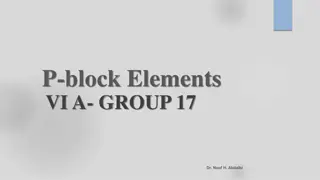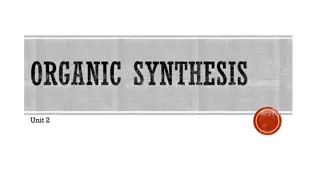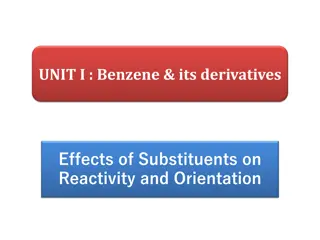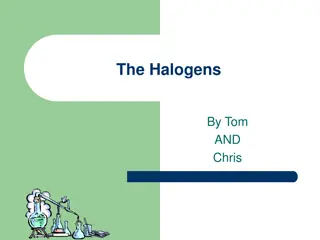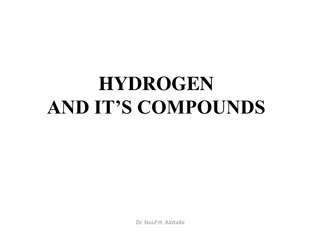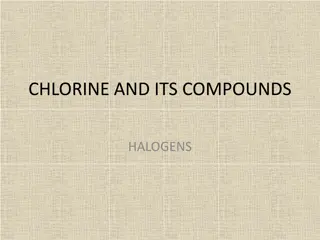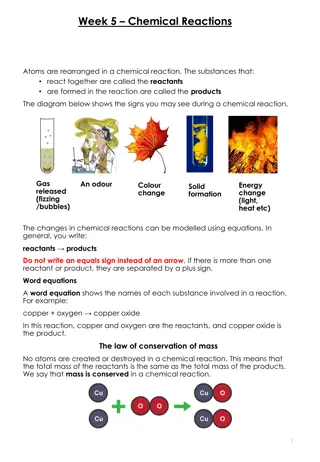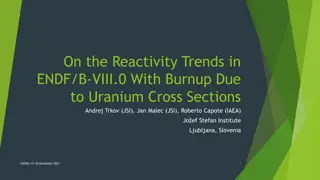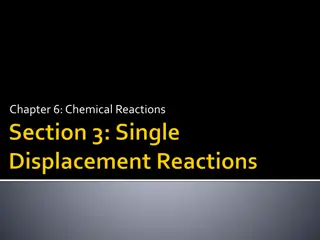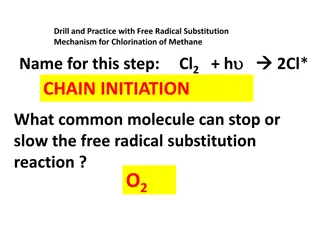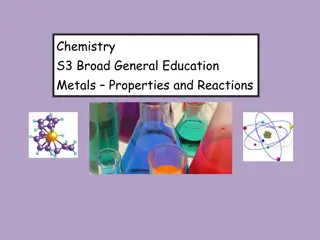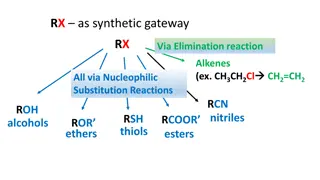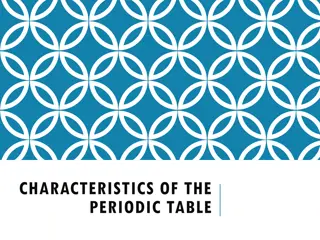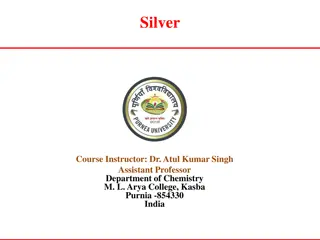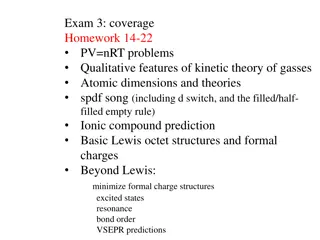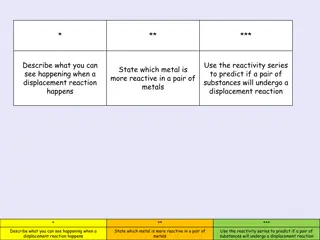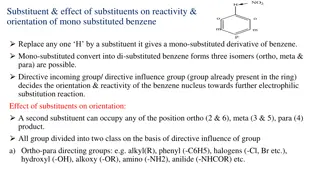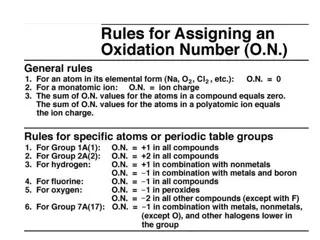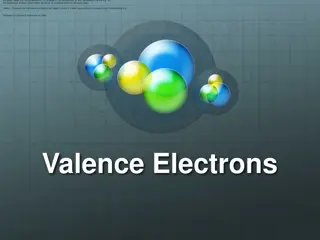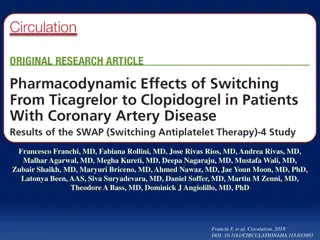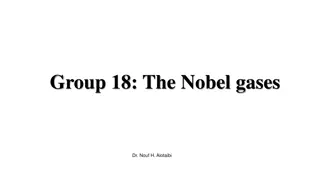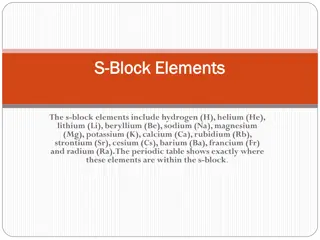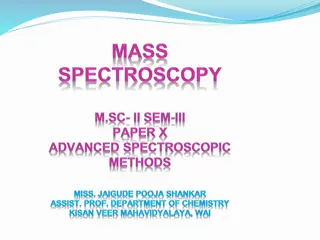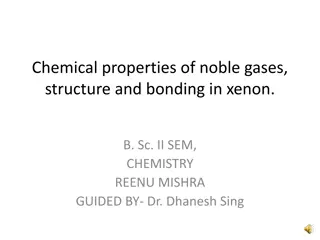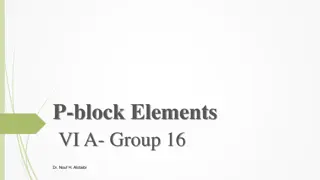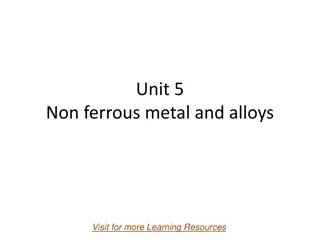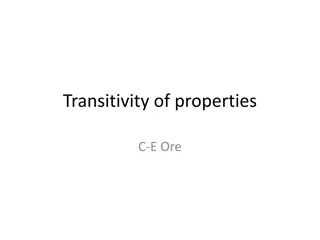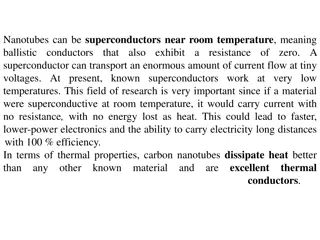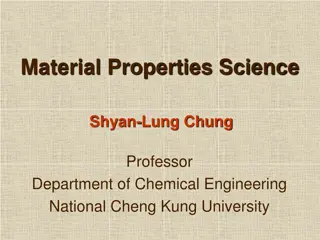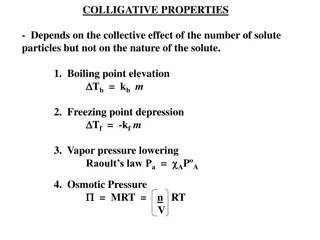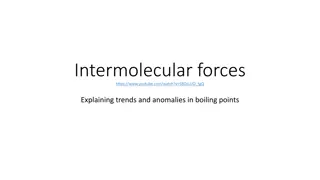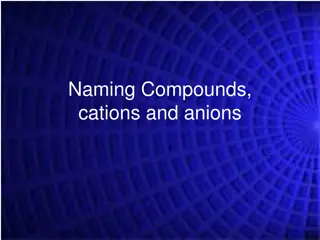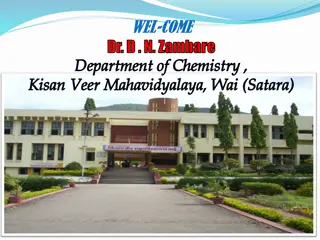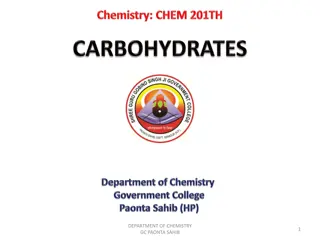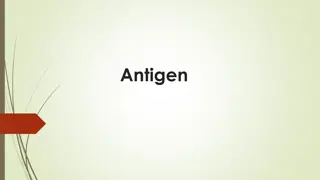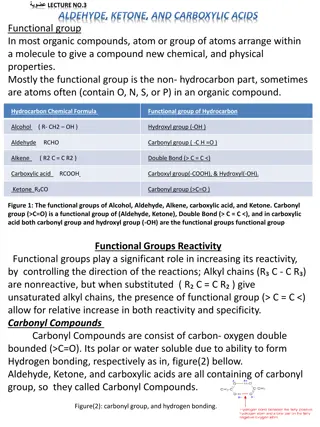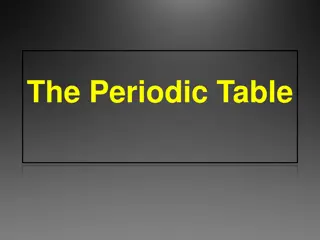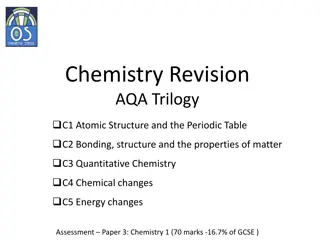Understanding Halogens: Properties, Reactivity, and Applications
Halogens are a group of reactive non-metals in the periodic table with unique properties. They have seven electrons in their outer shell, enabling them to easily form ions by gaining one electron. Due to their reactivity, halogens are commonly found in nature as salts, and their name reflects their salt-forming ability. Learn about their electron structure, why they are called halogens, and their applications in various compounds.
Download Presentation

Please find below an Image/Link to download the presentation.
The content on the website is provided AS IS for your information and personal use only. It may not be sold, licensed, or shared on other websites without obtaining consent from the author. Download presentation by click this link. If you encounter any issues during the download, it is possible that the publisher has removed the file from their server.
E N D
Presentation Transcript
Group 7: Halogens 1 of 32
Information Developing and Using Models Planning and Carrying Out Investigations Analyzing and Interpreting Data Using Mathematics and Computational Thinking Constructing Explanations and Designing Solutions 1. Patterns 6. Structure and Function 2 of 32
Columns of elements In the periodic table, the elements are arranged by their properties and the number of protons they contain. The vertical columns in the table are called groups. 1 2 groups 3 4 5 6 7 0 He H B C N O F Ne Li Be Al Si P S Cl Ar NaMg K Ca Sc Ti V Cr Mn Fe Co Ni Cu Zn Ga Ge As Se Br Kr Rb Sr Y Zr NbMo Tc RuRh Pd AgCd In Sn Sb Te I Xe Cs Ba La Hf Ta W Re Os Ir Pt AuHg Tl Pb Bi Po At Rn Fr Ra Ac Rf Db Sg Bh Hs Mt Ds RgCn Uut Fl Uup Lv UusUuo 3 of 32
Where are the halogens? Elements in the same group in the periodic table have very similar properties. This is because all elements in a single group have the same number of electrons in their outer shell, causing them to react in a similar manner. The elements in group 7, on the right of the periodic table, are called the halogens. fluorine F Cl chlorine H He B C N O F Ne Li Be Br bromine Al Si P S Cl Ar Na Mg K Ca Sc Ti V Cr Mn Fe Co Ni Cu Zn Ga Ge As Se Br Kr iodine I Rb Sr Y Zr Nb Mo Tc Ru Rh Pd Ag Cd In Sn Sb Te I Xe Cs Ba La Hf Ta W Re Os Ir Pt Au Hg Tl Pb Bi Po At Rn At Fr Ra Ac Rf Db Sg Bh Hs Mt Ds Rg Cn Uut Fl Uup Lv astatine Uus Uuo 4 of 32
What are the halogens? 5 of 32
Why are they called the halogens? Halogens are very reactive non-metals. As a result, they all have the potential to be toxic or harmful. Before antiseptics, iodine was used to clean wounds. This is because it is able to destroy harmful organisms, such as bacteria. Due to their reactivity, halogens are never found in nature in their pure form. Instead they are found in metal compounds. These halogen-metal compounds are called salts. This gives halogens their name halo-gen means salt-former. 6 of 32
Electron structure All halogens have seven electrons in their outer shell. This means that: They can easily obtain a full outer shell by gaining one electron. fluorine 2,7 They can gain an electron in reactions to form negative ions with a 1 charge. chlorine 2,8,7 They have similar chemical properties. 7 of 32
How do halogen molecules exist? To become stable, halogen atoms require one additional electron to obtain a full outer shell. Each atom can achieve this by sharing one electron with another atom to form a single covalent bond. + F This means that all halogens exist as diatomic molecules: F2, Cl2, Br2 and I2. 8 of 32
Testing for chlorine We can test for chlorine gas using damp blue litmus paper. The chlorine dissolves in the water on the paper, and then reacts with the litmus dye. First, the litmus paper will turn red. This is because chlorine is acidic. The paper will then be bleached white. Chlorine will also turn universal indicator paper red then white, and will turn starch-iodide paper from white to blue-black. 9 of 32
Identifying halide ions Halide ions are negative ions formed from the halogens. These can be detected using silver nitrate solution. The substance to be tested is first acidified with a small amount of nitric acid. Silver nitrate solution is then added. If a halide ion is present, a precipitate will form. The precipitates formed are silver halides. silver chloride+ sodium chloride+ silver nitrate sodium nitrate NaCl(aq) + AgNO3(aq) AgCl(s) + NaNO3(aq) Cl (aq) + Ag+(aq) AgCl(s) 10 of 32
Silver halides The different types of silver halide precipitates can be distinguished by their color. iodide chloride bromide yellow AgI precipitate white AgCl precipitate cream AgBr precipitate 11 of 32
What are the properties of the halogens? All the halogens are: non-metals and so do not conduct electricity brittle and crumbly when solid poisonous and strong-smelling. They become darker in color down the group: is a pale yellow gas at room temperature. fluorine chlorine is a green-yellow gas at room temperature. bromine is a dark orange liquid at room temperature. It becomes an orange-brown gas when heated. iodine is a dark grey solid at room temperature. It sublimes to a purple gas when heated. astatine is a dark-colored solid at room temperature. 12 of 32
Size, mass and density Going down group 7, the size, density and relative molecular mass of halogens all increase. relative density (g/cm ) element relative size molecular mass 38 0.0017 71 0.0032 160 3.1 254 4.9 astatine 420 approx 6.4* 13 of 32
Melting and boiling points The melting and boiling points of the halogens increase down the group. Predict the states and values to fill in the table. state at room temperature melting point ( C) boiling point ( C) element gas 220 188 gas 34 101 7 59 liquid 114 184 solid astatine solid 302* 337* 14 of 32
Reactions with metals and non-metals Halogens have 7 electrons in their outer shell. By gaining one more electron they can obtain a full shell and become stable. Metals need to lose electrons in order to gain a full outer shell. Metals can react with halogens to form ionic compounds called metal halides. sodium chloride Non-metals need to gain electrons to become stable. When non-metals react with halogens, they can share electrons and form covalent bonds. hydrogen chloride 16 of 32
What are halides? Halogen atoms can form negative ions by gaining an electron. When this happens, they are called halides. The name of each of the halogens changes once it has reacted. Instead of ending with ine, it ends with ide. halogen halide (F) fluoride (F ) (Cl) chloride (Cl ) (Br) bromide (Br ) (I) iodide (I ) 17 of 32
How do alkali metals react with halogens? The electron structure of halogens means that they react vigorously with group 1 alkali metals. An alkali metal has one electron in its outer shell. By losing this electron, it has a filled outer shell and forms a positive ion. 2.8.1 [2.8]+ A halogen has seven electrons in its outer shell. By gaining an electron from the alkali metal, it obtains a filled outer shell and forms a negative ion. 2.8.7 [2.8.8] 18 of 32
How are ionic bonds formed? The positive alkali metal ions and the negative halide ions are strongly attracted to each other. It is this electrostatic attraction that forms ionic bonds in metal halides and other ionic compounds. 19 of 32
Equations for halogens and alkali metals When a halogen reacts with a metal it forms a metal halide: halogen + metal metal halide Write a balanced symbol equation for the reaction between chlorine and sodium. sodium chloride 2NaCl chlorine + sodium + Cl2 2Na Write a word equation and a balanced symbol equation for the reaction between bromine and potassium. potassium bromide 2KBr bromine + potassium + Br2 2K 20 of 32
Electron structure and reactivity The reactivity of halogens decreases going down the group. What is the reason for this? The atoms of each element get larger going down the group. decrease in reactivity This means that the outer shell gets further away from the nucleus and is shielded by more electron shells. The further the outer shell is from the positive attraction of the nucleus, the harder it is to attract another electron to complete the outer shell. Cl 21 of 32
Halogen reaction with iron wool 22 of 32
What is the reactivity of the halogens? The iron wool experiment shows that the reactivity of halogens decreases down the group. halogen reaction with iron wool Iron wool burns and glows brightly. Iron wool glows, but less brightly than with chlorine. Iron wool has a very slight glow. Astatine appears directly below iodine in group 7. Fluorine appears directly above chlorine. How do you think astatine and fluorine would react with iron wool? 23 of 32
How do the halogens react with hydrogen? Halogens react with hydrogen to create hydrogen halides. + chlorine hydrogen hydrogen chloride When halogens react with non-metals, they can share electrons to form a covalent compound. All hydrogen halides are gases. They dissolve easily in water and form strong acids. 24 of 32
Reactions with other non-metals As well as hydrogen, other non-metals can react with halogens to form covalent compounds. These include: halohydrocarbons, e.g. Chloromethane, PVC, PTFE phosgene (COCl2), used as a chemical weapon in WW1 silicon tetrachloride (SiCl4), used to produce high purity silicon nitrogen tribromide (NBr3), extremely explosive sulfur dichloride (SCl2), used in the process of making sulfur compounds. 25 of 32
True or false? 26 of 32
Displacement of halogens If a halogen is added to a solution of a compound containing a less reactive halogen, it will react with the compound and form a new one. This is called displacement. sodium chloride sodium fluoride fluorine + + chlorine + + F2(aq) 2NaCl(aq) 2NaF(aq) Cl2(aq) A more reactive halogen will always displace a less reactive halide from its compounds in solution. Why will a more reactive halogen always displace a less reactive halogen? 27 of 32
Displacement theory Fluorine is more reactive than chlorine. What happens when fluorine is added to sodium chloride? The products of the reaction are sodium chlorine and sodium fluoride. chloride chlorine The chlorine has been displaced by the fluorine. - In sodium chloride, the outer shell electron from the sodium atom has been transferred to the chlorine atom, to make sodium and chloride ions. from chlorine to fluorine. atom becomes a fluoride ion. When fluorine is added, the extra electron will be transferred chlorine atom, and the fluorine The chloride ion becomes a sodium fluorine fluoride fluoride 28 of 32
Reduction and oxidation During a displacement reaction, the less reactive halogen is oxidized (loses an election) and the more reactive halogen is reduced (gains an electron). + Oxidation: 2Cl- 2e- Cl2 + Reduction: F2 2e- 2F- The reaction involves both reduction and oxidation, so it is a redox reaction. Remember OIL RIG: Oxidation Is Loss of electrons, Reduction Is Gain of electrons. 29 of 32
Displacement reactions 30 of 32
Predicting displacement reactions What will happen if bromine is added to sodium iodide? The bromine will displace the iodide ion in the solution to form sodium bromide. Write a word equation and a balanced symbol equation for this reaction. sodium iodide sodium bromide bromine + + iodine + + Br2 2NaI 2NaBr I2 31 of 32
Is there a displacement reaction? 32 of 32


